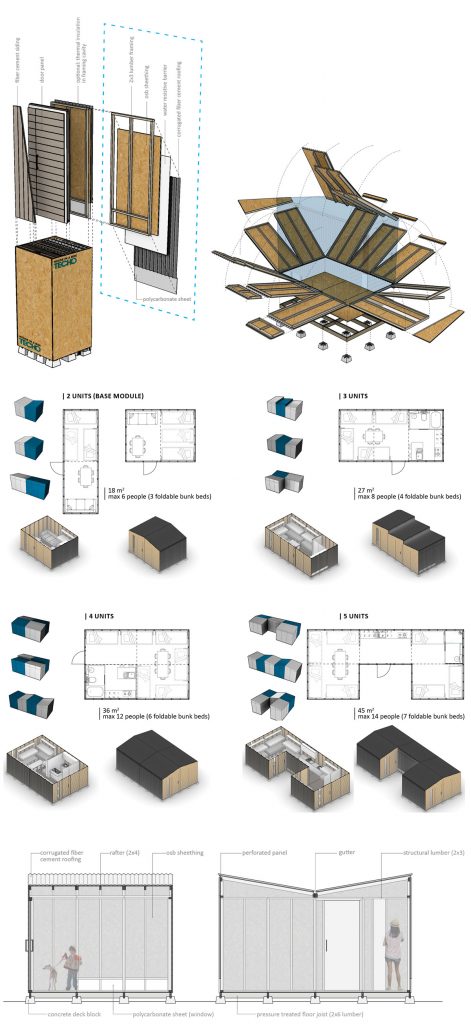We propose a modular emergency home that strategically integrates versatile modular system design with an intelligent prefabrication process. The base unit is a simple 9 m2 box with a shed type roof. Two base units are combined – as a butterfly, gable, or elongated shed type – to form the 18 m2 module for up to 5 habitants. Each base unit can serve as a bedroom area, living area, or configured to house the bathroom/ kitchen/ storage functions. The size and capacity of the home can incrementally increase by adding additional base units. This creates a variety of spatial, functional, and formal configurations that adapt to the needs and sizes of any family.
The construction process follows the house in a box method where the components of each 9 m2 unit is packages into a 4 x 4 x 8 feet (approximately 1.2 x 1.2 x 2.4 meters) box. Two of these boxes can be shipped to the site and used to construct one 18 m2 base module. The components of the units are intended to be partially prefabricated into a series of 4 x 8 feet structural panels consisting of structural lumber (2×3 and 2×4), sheathing (plywood or oriented strand board), and exterior finish (fiber cement siding or corrugated fiber cement roofing). The current design proposes concrete deck blocks as the foundation; and polycarbonate sheets for glazing but alternative materials can be utilized based on cost and availability (e.g. CMU, brick, or paving block for foundation; and glass, transparent corrugated fiberglass, or acrylic sheets for glazing). Non-specialist volunteers can construct the home within 2 days using simple tools such as shovels, hammers, and screwdrivers; due to the reduced number of components enabled by prefabrication.
The House in a Box utilizes several simple yet effective strategies for increasing its building performance. By strategically locating fenestrations (i.e. windows and perforated screens) near the floor of the building as well as near the roof on both sides of the home, it is possible to utilize both modes of natural ventilation (stack ventilation and cross ventilation). Water collection can be easily implemented by placing a water tank directly under the low point of the gutter. Finally, by using concrete blocks for foundation, pressure-treated lumber for floor joists, and implementing a water-resistive barrier (i.e. house wrap, building paper, or felt) between the exterior cladding and sheathing (also optionally integrate thermal insulation); the home will be pleasant to live in for many years to come.

